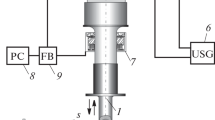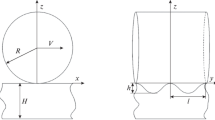Abstract
It is shown that the introduction of torsional ultrasonic oscillations in the deformation source reduces the work of the frictional forces in comparison with the application of radial and longitudinal ultrasound or the absence of ultrasound. The application of torsional ultrasound to the deforming element reduces the contact-friction coefficient by a factor of 20–60, as against a factor of two or less when radial and longitudinal ultrasound is applied to the contact zone. With increase in the rolling rate and decrease in oscillation amplitude of the deforming element, the effectiveness of ultrasound application declines.
Similar content being viewed by others
References
Severdenko, V.P., Klubovich, V.V., and Stepanenko, A.I., Ul’trazvuk i plastichnost’ (Ultrasound and Plasticity), Minsk: Nauka i Tekhnika, 1976.
Volodin, M.F., Kalashnikov, V.V., Nerubai, M.S., and Shtrikov, B.L., Primenenie ul’trazvuka pri obrabotke i sborke (Ultrasound in Machining and Assembly), Moscow: Mashinostroenie, 2002.
Markov, A.I., Ul’trazvukovaya obrabotka materialov (Ultrasound Treatment of Masterials), Moscow: Mashinostroenie, 1980.
Ul’trazvuk. Malen’kaya entsiklopediya (Ultrasound: A Concise Encyclopedia), Golyamin, I.P., Ed., Moscow: Sovetskaya Entsikopediya, 1979.
Kuchling, H., Taschenbuch der Physik, Frankfurt: Harri Deutsch, 1981.
Petukhov, V.I., Abramov, O.V., and Kulemin, A.V., Influence of Ultrasound on the Contact Friction between Metals, Primenenie novykh fizicheskikh metodov dlya intensifikatsii metallurgicheskikh protsessov: Nauch. tr. MISIS (New Physical Methods for the Intensification of Metallurgical Processes: Proceedings of the Moscow Institute of Steel and Alloys), Khavskii, N.N., Ed., Moscow: Metallurgiya, 1974, no. 77, pp. 211–215.
Konovalov, E.G. and Basenok, G.S., Investigating the Influence of Ultrasound on the Friction and Wear of Solids at High Temperatures, Primenenie novykh fizicheskikh metodov dlya intensifikatsii metallurgicheskikh protsessov: Nauch. tr. MISIS (New Physical Methods for the Intensification of Metallurgical Processes: Proceedings of the Moscow Institute of Steel and Alloys), Khavskii, N.N., Ed., Moscow: Metallurgiya, 1974.
Smelyanskii, V.M., Mekhanika uprochneniya poverkhnostii plasticheskim deformirovaniem (Mechanics of Surface Hardening by Plastic Deformation), Moscow: Mashinostroenie, 2002.
Ul’trazvukovaya tekhnologiya (Ultrasonic Technology), Agranat, B.A., Ed., Moscow: Metallurgiya, 1974.
Gavrilova, T.M., Influence of Ultrasound on the Surface Quality in Machining, Izv. Vyssh. Uchebn. Zaved., Mashinostr., 2003, no. 8, pp. 37–43.
Author information
Authors and Affiliations
Additional information
Original Russian Text © T.M. Gavrilova, 2008, published in Vestnik Mashinostroeniya, 2008, No. 8, pp. 36–40.
About this article
Cite this article
Gavrilova, T.M. Contact friction in the deformation zone during ultrasonic surface plastic deformation. Russ. Engin. Res. 28, 764–768 (2008). https://doi.org/10.3103/S1068798X08080078
Published:
Issue Date:
DOI: https://doi.org/10.3103/S1068798X08080078




